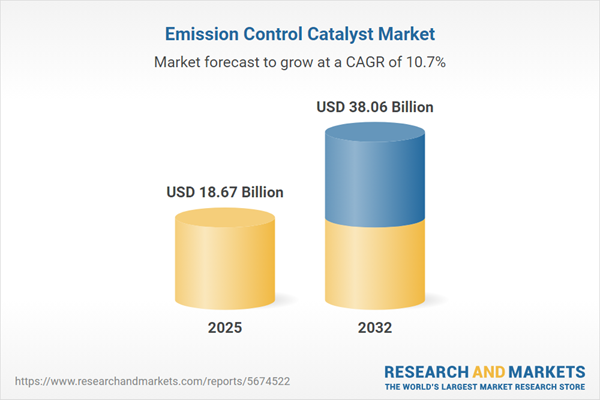Speak directly to the analyst to clarify any post sales queries you may have.
The emission control catalyst market is advancing as shifting regulations, robust technology adoption, and an increased emphasis on sustainability reshape industry priorities. B2B organizations are adapting strategies to balance compliance, cost, and efficiency within this evolving landscape.
Market Snapshot: Emission Control Catalyst Market Performance and Outlook
From 2024 to 2025, the global emission control catalyst market grew from USD 16.82 billion to USD 18.67 billion, representing a 10.74% compound annual growth rate (CAGR). Market forecasts indicate this sector will reach USD 38.06 billion by 2032, driven by the enforcement of strict environmental standards and greater sustainability initiatives. Automotive applications currently claim the largest market portion, while industrial segments in marine, chemical, and power generation demonstrate increasing adoption. Companies at the forefront are employing innovative catalyst technology to meet compliance demands and help B2B customers manage operational costs and complex technical criteria.
Scope & Segmentation
- End Use Industries: Automotive, industrial, marine, chemical processing, and power generation each call for tailored emission control catalysts, reflecting diverse compliance and performance requirements relevant to sector specifics.
- Distribution Channels: Both original equipment manufacturers and aftermarket distributors enable catalyst integration for new assets or retrofits, supporting a full range of procurement and maintenance models.
- Catalyst Types: Diesel oxidation catalysts, lean NOx traps, selective catalytic reduction systems, and three-way catalysts are used strategically to address sectoral emission challenges and compliance thresholds.
- Applications: On-road and off-road vehicles, as well as passenger and commercial fleets, benefit from these technologies, enabling organizations to meet varying legal and operational stipulations.
- Material Types: Solutions include catalysts containing base metals and precious metals such as platinum, palladium, and rhodium, prioritized for efficiency, supply resilience, and lifecycle optimization.
- Regional Coverage: The Americas, Europe, the Middle East, Africa, and Asia-Pacific exhibit varied adoption speeds based on regulatory climate and modernization. Emerging economies like China, India, and Southeast Asia are experiencing swift growth, accelerating modernization and production capacity with targeted capital investment.
- Key Companies: Johnson Matthey PLC, BASF SE, Umicore SA, Clariant AG, Haldor Topsoe A/S, Evonik Industries AG, W. R. Grace & Co., Heraeus Holding GmbH, Cormetech Inc., and NOF Corporation maintain strong influence across established centers and emerging hubs of activity.
Key Takeaways for Senior Decision-Makers
- Align research and development with anticipated regulatory trends to enhance compliance and operational capabilities across global and regional facilities.
- Invest in technology partnerships and upgrade production infrastructure to facilitate swift deployment of next-generation emission control solutions and maintain competitiveness.
- Broaden sourcing approaches, including diversification of supplier partnerships, to ensure catalyst quality and mitigate disruptions tied to fluctuating material markets.
- Adopt recycling and closed loop systems to drive sustainable resource use and reinforce long-term operational resilience.
- Utilize digital monitoring, predictive maintenance, and lifecycle optimization to extend catalyst and equipment uptime and manage upgrade timing more effectively.
- Pursue targeted alliances, partnerships, and M&A activities to maintain agility amid a dynamic regulatory and commercial environment.
Tariff Impact and Supply Chain Adaptation
The introduction of new U.S. tariffs on catalyst materials has prompted companies to reevaluate procurement and production strategies. To address these challenges, organizations are expanding sourcing networks, considering regional production shifts, and analyzing the benefits of nearshoring. Enhanced focus on recycling and resource recovery initiatives is supporting supply chain flexibility and helping meet evolving global compliance expectations.
Methodology & Data Sources
This analysis integrates primary research through interviews with key industry stakeholders, robust data modeling, and an in-depth review of regulatory and technical records. Strict quality controls have been implemented to ensure that market segment forecasts are accurate and the strategic guidance holds practical relevance.
Why This Report Matters for the Emission Control Catalyst Market
- Provides comprehensive segmentation and regional insights, helping executive leadership align with emerging regulatory requirements and strengthen strategies for emission control solutions.
- Offers actionable guidance for investment and partnership opportunities, supporting robust strategic planning within both mature and rapidly developing markets.
- Enables optimization of digital infrastructure, regulatory workflows, and sourcing networks for durable supply chains and business continuity in a changing compliance landscape.
Conclusion
Adapting to the evolving emission control catalyst market requires a proactive focus on innovative technology and robust supply chains. Companies committed to modernization and strategic collaboration are positioned to navigate regulatory and operational transitions with confidence.
Additional Product Information:
- Purchase of this report includes 1 year online access with quarterly updates.
- This report can be updated on request. Please contact our Customer Experience team using the Ask a Question widget on our website.
Table of Contents
3. Executive Summary
4. Market Overview
7. Cumulative Impact of Artificial Intelligence 2025
Companies Mentioned
The companies profiled in this Emission Control Catalyst market report include:- Johnson Matthey PLC
- BASF SE
- Umicore SA
- Clariant AG
- Haldor Topsoe A/S
- Evonik Industries AG
- W. R. Grace & Co.
- Heraeus Holding GmbH
- Cormetech Inc.
- NOF Corporation
Table Information
| Report Attribute | Details |
|---|---|
| No. of Pages | 198 |
| Published | October 2025 |
| Forecast Period | 2025 - 2032 |
| Estimated Market Value ( USD | $ 18.67 Billion |
| Forecasted Market Value ( USD | $ 38.06 Billion |
| Compound Annual Growth Rate | 10.7% |
| Regions Covered | Global |
| No. of Companies Mentioned | 11 |









